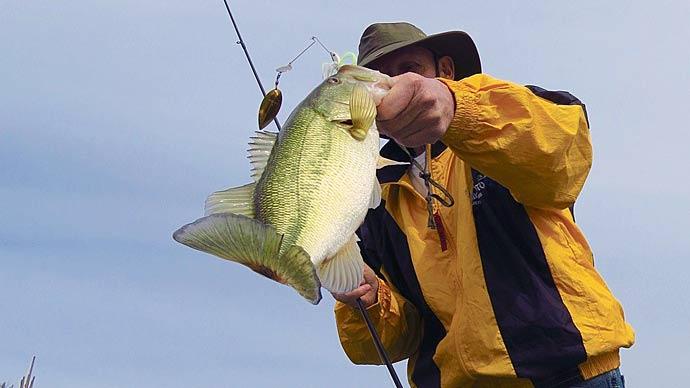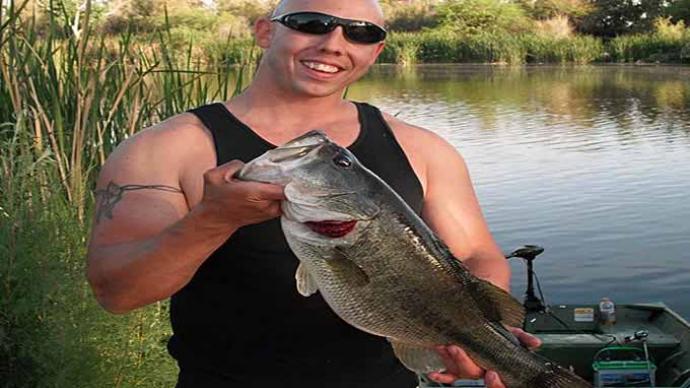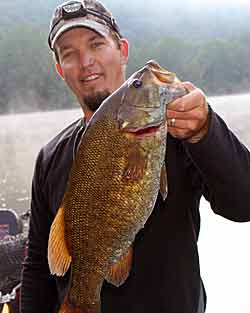
I put one tackle box and one rod in the boat. The purpose of this trip wasn’t to see what was biting. It was a mission to fix a problem, and a small body of water was a big part of the solution.
I was getting waxed in tournaments by club members who were fishing jigs. I had thrown jigs a lot, and I liked to fish them. But I recently shelved them for soft plastics, hoping I would generate more bites. I did, but day in and day out, those bass didn’t weigh enough to place. So to keep pace, I needed to relearn how to fish jigs. I pared down my tackle to just a few jigs and some trailers, so I wouldn’t be tempted to try a different lure and launched my boat into a 576-acre lake. I tied on a jig and went to work. I eased the boat along a row of docks, softly skipping my jig underneath each one, and the boats moored alongside. It was under the third dock that the jig never hit bottom. Instead, it began swimming back to me. I set the hook on a nice 3-pounder. That one fish re-ignited my love for jig fishing, and the others that day stoked that fire. I haven’t let it burn out since. But what fanned the flame was fishing a small body of water.
Big lakes and rivers draw a lot of angling attention. They have the most access, host many tournaments, and have lots of room for anglers to fish. But chances are good there is a small lake — 1,500 acres or less — or a small river near your home. These aren’t the ponds in a farmer’s field or behind someone’s house, though those can be great places to catch bass, too. These lakes are public and waiting to be fished. You might have fished them in the past, but maybe limited parking at the ramp or practicing for tournaments sent you elsewhere. It’s time to fish them again. They pack many potential fishing scenarios in an easily navigable package. That makes trying new patterns and lures a simple process. Not to mention you can catch a lot of bass from them.
More options, less water
Small lakes like the one I chose to practice jig fishing are scattered across the country, and most have a variety of depth, structure, and cover options, giving you the chance to experiment with new techniques and lures quickly. I could have towed to a lake ten times the size, but it might have taken me ten times as long to get a bite. It’s a long run from shallow docks to deep grass lines there. I only needed to use my trolling motor to find both scenarios and more by choosing a small lake. If the docks weren’t working, it was a short move to the middle of a submerged weed bed, then another short troll to the outside edge. That allowed me to focus on fishing, not traveling.
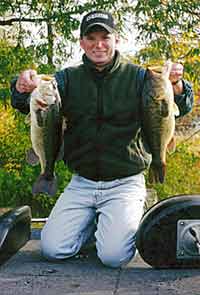
Britt Stoudenmire has learned a lot while fishing a small river. His guide service — Pembroke, Va.-based New River Outdoor Co. — chases smallmouth on the New River in southwest Virginia. “The experience is more intimate, up close, and personal,” he said. The smallies in this river — one of the oldest in the world — have all they need close by. They spend their entire lives in 100- to 200-yard stretches. “I never have to go far to change patterns,” he said. He primarily fishes mid-river ledges and current seams or breaks. “I don’t fish a lot of really deep water for smallies. The fish will go extremely shallow several times a year, particularly during and after the spawn and again in August and September when they head to the banks looking for cicada bugs.”
Learn new lures
There are fewer places for bass to hide on small lakes and rivers, so you spend less time looking for them and more time figuring out how to generate strikes with a new lure. Like their cousins in bigger bodies of water, small-lake bass are conditioned by their environment. If it’s shallow and weedy, you’ll have to flip and frog them out, and if it is deep and clear, you’ll need to add drop shots and cranks to the mix. You’ll find places to throw all of those lures on some small lakes or rivers. “I fish the whole gamut,” Stoudenmire said, “tubes, jigs, worms, flukes, jerkbaits, crankbaits, spinnerbaits, topwater — buzzbaits, Pop-Rs, Sammies, etc.”
Having lure options is good, but so is limiting your choices. If you want to learn how to use crankbaits, for example, then just bring those. By bringing one type of lure, you won’t be distracted by the others in your tackle box. Yes, you do run the risk of coming home empty-handed, but your chances of successfully learning a new lure are better. “I add a ‘new-to-me’ lure to the lineup every year that I think will show the fish something different,” Stoudenmire said. “Some work and some don’t.”
Learn new patterns
Knowing how to fish different lures is about 30 percent of bass fishing success. The balance is finding the correct combination of structure and cover to fish under current conditions. On a large lake, running through different combinations, unless you’re lucky enough to find them in one creek arm, can mean traveling great distances. On a small lake, it means idling from one side of the lake to the other.
Take, for example, an evening trip to a small lake in the northern part of the country. It was one of those summer days when the wind whips and the temperature plummeted after a severe cold front passed. I was fishing a small reservoir, just 275 acres. I bounced around the usual spots for about an hour without any bites. Then I went to a new spot: a narrow weedbed between the bank and a channel swing. Working the inside grass line with a Slider worm, I quickly caught five bass. That was more fish than was reported by all the other boats taking out with us at dusk.
Cycling through potential fishing spots on a larger lake takes much longer. And even if I quickly found the inside weedline pattern there, I still have miles of it to fish. If your time is limited, smaller lakes quickly let you sort through potential fishing spots —and find bass.
Learn their world
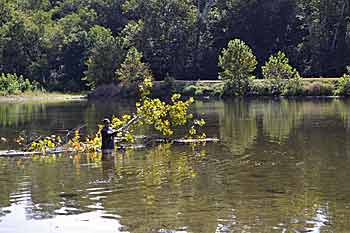
Smallmouth and largemouth make their homes in shallow rivers across the country. Some flow quickly, and others meander quietly. If you watch your step, you can walk with the bass.
Wading is a great way to access these rivers, where rapids or lack of boat ramps can keep even the smallest craft on its trailer. Unless it’s right after a heavy rain, the water in these rivers runs clear. That lets you see the bass as they swim around. You can watch where they rest and use current breaks to move around and feed. You just need an old pair of sneakers — maybe a set of waders if you want to get fancy or the water is colder than you prefer — and a pair of quality polarized sunglasses. And wading isn’t limited to rivers and streams. You can wade in small lakes, too.
On a recent trip to the mountains of central Virginia, I had a chance to join the smallmouth that swim in the south fork of the Shenandoah River. Standing on a large flat rock, water up to my knees, I watched a school of them chase my spinnerbait and then Senko. Each time they’d peel off halfway back and return to one current break, which was a large patch of river grass. They didn’t spend much time in the open. Instead, they used an edge, whether the grass or a shallow rock ledge, to get from one spot to another.
These observations are tough to make on a large lake or river. You might not see the bass there, but if you apply what you’ve seen on smaller bodies of water, you’ll know how bass set up behind current breaks or spend more time around the irregularities in the grass. And you’ll know to keep casting along the edge, or at least to it, not wasting retrieves through open water. If you know where the structure or cover is on a reservoir and the direction of the current, for example, it will be easier to visualize where the bass will be and how best to present your lure to them.
Hawg holes
There may be more big bass in large lakes and rivers, but small lakes and rivers have brutes, too. Stoudenmire has pulled several 6-pound smallies from the New River, but one day stands out for big fish. He had guided clients for an entire day in early April, and they only had one fish at 5:30 p.m. Then the fishing flowed. One flurry produced smallies weighing 6 pounds and 9 ounces, 4 pounds and 8 ounces, and 5 pounds and 2 ounces on consecutive casts. “You can never give in when hunting for big smallies,” he said. “Our biggest client catch is 22.5 inches and 6 pounds and 9 ounces after it spit up several bream and crawfish during the fight. It was a real beast.”
I’ve caught several largemouths over 6 pounds in small lakes. While each makes for a great memory, big bass are not the primary reason to fish smaller bodies of water. Catching your first five or six bass off a rock pile in 15 feet of water on a deep-running crankbait, for example, will do more for your confidence than one 6-pounder fishing the same way.
Small to big
No one will blame you if you keep fishing small lakes once you start. Having many fishing situations and bass within easy reach is fun. But there may come a time when you want to fish a bigger lake, or maybe your next tournament is on a big river. You might be leaving the friendly confines behind, but what you learned on those smaller bodies of water transfers quickly to bigger bodies of water. “I have chased big smallies all over the country, even applying river smallie techniques on Lake Erie and taking Erie techniques back to the New River,” Stoudenmire said. While it won’t be an exact transfer, small-water experiences will help you get close to where you need to be to start catching.
That’s what happened with my jig fishing. I posted several good finishes the season after I went to that small lake to relearn it. The highlight was a win on the St. Lawrence River, which at 740 miles long, is not a small body of water. I weighed in 17 pounds and 1 ounce of largemouth, including the tournament and season lunker, a 6-pound 10-ounce northern giant. They were all caught on jigs.
Small lakes and rivers can help you become a better bass angler faster. You may not bring a trophy home after fishing one, but you will bring home knowledge that can help you win one elsewhere.



